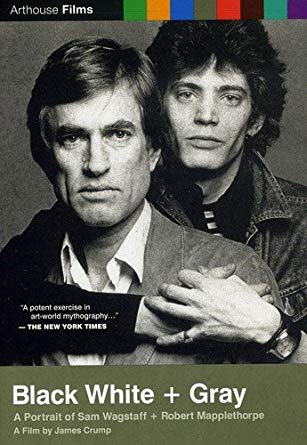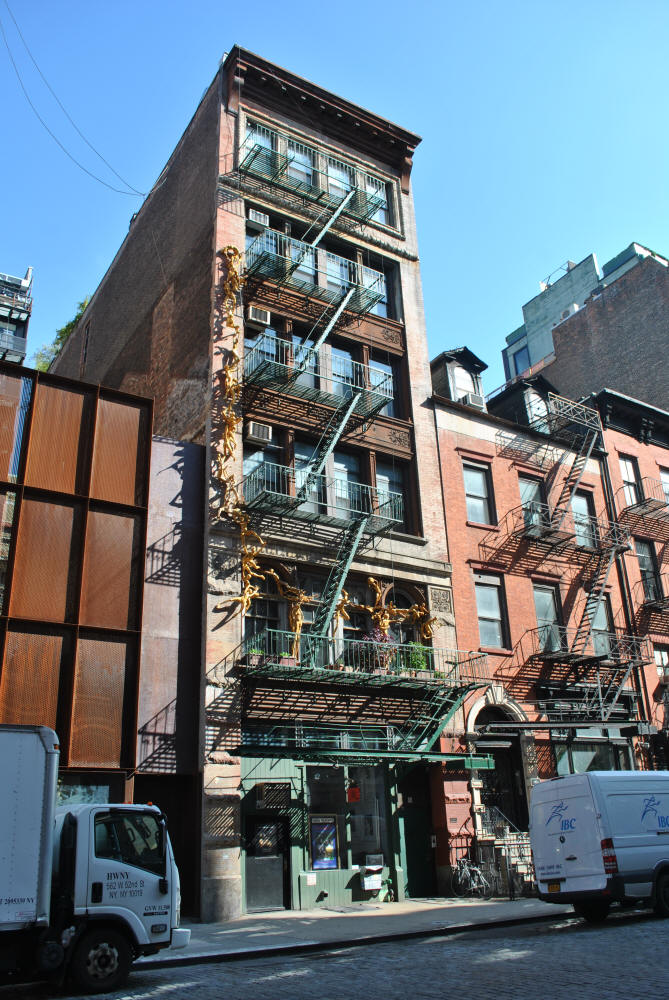Queer Places:
Pratt Institute, 200 Willoughby Ave, Brooklyn, NY 11205, Stati Uniti
Hotel Chelsea, 222 W 23rd St, New York, NY 10011, Stati Uniti
35 W 23rd St, New York, NY 10010, Stati Uniti
24 Bond St, New York, NY 10012, Stati Uniti
St. John Cemetery, Middle Village, Queens, NY, Stati Uniti
 Robert Mapplethorpe (November 4, 1946 – March 9, 1989) was an American
photographer, known for his sensitive yet blunt treatment of controversial
subject-matter in the large-scale, highly stylized black and white medium of
photography. His work featured an array of subjects, including celebrity
portraits, male and female
nudes,
self-portraits and still-life images of flowers. His most controversial work
is that of the
underground BDSM
scene in the late 1960s and early 1970s of
New York City. The
homoeroticism of this work fuelled a national debate over the public
funding of controversial artwork.
Robert Mapplethorpe (November 4, 1946 – March 9, 1989) was an American
photographer, known for his sensitive yet blunt treatment of controversial
subject-matter in the large-scale, highly stylized black and white medium of
photography. His work featured an array of subjects, including celebrity
portraits, male and female
nudes,
self-portraits and still-life images of flowers. His most controversial work
is that of the
underground BDSM
scene in the late 1960s and early 1970s of
New York City. The
homoeroticism of this work fuelled a national debate over the public
funding of controversial artwork.
Mapplethorpe was born in
Floral Park, Queens, New York City, the son of Joan Dorothy (Maxey) and
Harry Irving Mapplethorpe, an electrical engineer.[1]
He was of
English,
Irish, and
German descent, and grew up as a
Roman Catholic in Our Lady of the Snows Parish. He had five brothers and
sisters.[2]
He studied for a
Bachelor of Fine Arts from the
Pratt Institute in
Brooklyn,
where he majored in Graphic Arts,[3]
though he dropped out in 1969 before finishing his degree.[4]
Mapplethorpe lived with his close friend
Patti
Smith from 1967 to 1972, and she supported him by working in bookstores.
They created art together, and maintained a close relationship.
Mapplethorpe took his first photographs in the late 1960s or early 1970s
using a
Polaroid camera. In 1972 he met art curator
Sam
Wagstaff who would become his mentor and lifetime companion. In the
mid-1970s Wagstaff acquired a
Hasselblad medium-format camera and Mapplethorpe began taking photographs
of a wide circle of friends and acquaintances, including artists, composers,
and socialites. During this time, he became friends with
New
Orleans artist
George Dureau, whose work had such a profound impact on Mapplethorpe that
he restaged many of Dureau's early photographs. From 1977 until 1980,
Mapplethorpe was the lover of writer and
Drummer magazine editor
Jack Fritscher,[5]
who introduced him to
Mineshaft.
By the 1980s Mapplethorpe's subject matter focused on statuesque male and
female nudes, delicate flower still lifes, and highly formal portraits of
artists and celebrities. Mapplethorpe's first studio was at 24
Bond Street in Manhattan. In the 1980s, Wagstaff bought a top-floor loft
at 35 West 23rd Street for Robert, which he lived in and used as his shooting
space.[6]
He kept the Bond Street loft as his darkroom. In 1988, Mapplethorpe selected
Patricia Morrisroe to write his biography, which was based on more than 300
interviews with celebrities, critics, lovers, and Mapplethorpe himself.[6]

DON HERRON (1941-2012)
Keith Haring * Robert Mapplethorpe.
Together, 2 silver prints, the images measuring 187.3x127 mm; 7 3/8x5 inches, the sheets 254x203.2 mm; 10x8 inches, each with Herron's signature, title, and date, in pencil, on recto, and a Ross Bennett Lewis Collection label on frame verso. 1978 & 1982.
.jpg)
Mel Odom by Robert Mapplethorpe

Giorgio di Sant' Angelo
negative 1977; print 1978
Robert Mapplethorpe (American, 1946 - 1989)
.jpg)
Hotel Chelsea, New York City

24 Bond St
.JPG)
35 W 23rd St
Mapplethorpe died on the morning of March 9, 1989 at the age of 42 due to
complications from
HIV/AIDS,
in a Boston,
Massachusetts hospital. His body was cremated. His ashes are interred at
St. John's Cemetery, Queens in
New York, at his mother's grave-site, etched "Maxey".[7]
Nearly a year before his death, the ailing Mapplethorpe helped found the
Robert Mapplethorpe Foundation, Inc. His vision for the Foundation was that it
would be "the appropriate vehicle to protect his work, to advance his creative
vision, and to promote the causes he cared about".[8]
Since his death, the Foundation has not only functioned as his official estate
and helped promote his work throughout the world, but it has also raised and
donated millions of dollars to fund medical research in the fight against AIDS
and HIV infection.[8]
The Foundation also determines which galleries represent Mapplethorpe's art.[9][10]
The Robert Mapplethorpe Foundation donated the Robert Mapplethorpe Archive to
the
Getty Research Institute. The archive spans from 1970 to 1989.[11]
My published books:


BACK TO HOME PAGE

 Robert Mapplethorpe (November 4, 1946 – March 9, 1989) was an American
photographer, known for his sensitive yet blunt treatment of controversial
subject-matter in the large-scale, highly stylized black and white medium of
photography. His work featured an array of subjects, including celebrity
portraits, male and female
nudes,
self-portraits and still-life images of flowers. His most controversial work
is that of the
underground BDSM
scene in the late 1960s and early 1970s of
New York City. The
homoeroticism of this work fuelled a national debate over the public
funding of controversial artwork.
Robert Mapplethorpe (November 4, 1946 – March 9, 1989) was an American
photographer, known for his sensitive yet blunt treatment of controversial
subject-matter in the large-scale, highly stylized black and white medium of
photography. His work featured an array of subjects, including celebrity
portraits, male and female
nudes,
self-portraits and still-life images of flowers. His most controversial work
is that of the
underground BDSM
scene in the late 1960s and early 1970s of
New York City. The
homoeroticism of this work fuelled a national debate over the public
funding of controversial artwork.
.jpg)

.jpg)

.JPG)

